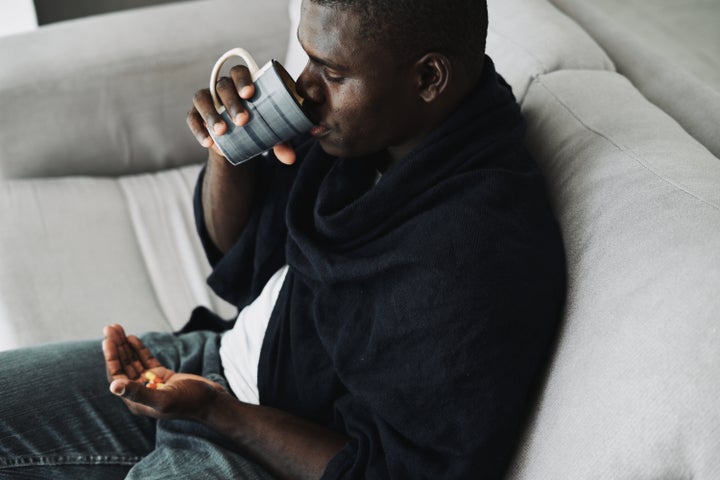Many have experienced body aches, back pain and calf pain with a COVID infection recently. Here’s why that may be happening.
At the start of the pandemic, loss of taste and smell and difficulty breathing were two of the telltale signs that you might be infected with COVID. But as the coronavirus evolved and variants emerged, different symptoms became more common. Now, back pain and muscle aches rank in the list of symptoms frequently reported with omicron.
Data from South Africa’s omicron wave first confirmed that myalgia, and back pain specifically, was on the rise in COVID patients. Similar reports have come out of India and Norway — more people infected with COVID are experiencing back pain and muscle aches. And sometimes that pain is pretty severe.
According to pain and spine specialists, the most likely culprit is all the inflammation that comes with a viral infection, which can agitate our muscles and joints. Though it’s too soon to know for sure, some doctors suspect there may be something unique to omicron and the way it impacts the musculoskeletal system.
“COVID is what we call a bad player. It really can mimic so many different conditions and cause so many types of symptoms — whether it’s affecting the pulmonary system or the musculoskeletal system or your heart,” Peter Whang, a Yale Medicine orthopedic spine surgeon and associate professor at Yale University School of Medicine, told HuffPost.
Why might COVID cause back pain?
During viral infections, the body releases a ton of small proteins called cytokines to rev up the immune system in order to fight the pathogen. According to Jacob Hascalovici, a neurologist, interventional pain specialist and the chief medical officer and co-founder of chronic pain telehealth platform Clearing, one of the consequences of these pro-inflammatory cytokines is that they can greatly irritate muscles and joints.
It’s not just the coronavirus that triggers this type of reaction. Back pain and muscle aches are commonly reported with other viral and bacterial infections, too — like the flu, adenoviruses and rhinoviruses. Whang said this large immune response, which is part of the body’s natural response to viruses, can elicit a lot of musculoskeletal complaints.
With COVID, much of the aches and pain being reported involve the muscles and soft tissues around the joints — it’s not causing structural issues or causing the discs to wear down quicker, according to Whang.
People with preexisting back issues are also experiencing flare-ups when infected with COVID. According to Patrick Doherty, a neurosurgeon and spine surgeon with Yale Medicine, the inflammatory reaction can be more problematic and aggravating in people with underlying health issues like chronic back pain, which is why the infection seems to exacerbate preexisting symptoms in areas of weakness.
Hascalovici said the inflammation COVID causes can unmask underlying problems, too. For example, a person could have arthritis that is not symptomatic.
“The infection, in creating some inflammation in and around that area of arthritis that normally was not causing any symptoms, is now a new presentation,” Hascalovici said.

Does omicron cause more back pain than other variants?
This is still up in the air. During the early stages of the pandemic, patients frequently reported lung issues and loss of taste and smell. These symptoms aren’t as common with omicron. Doherty said he has treated more patients with back aches during the omicron wave.
“With omicron, we are definitely seeing more complaints of back pain, even after they’ve recovered, and we’re not exactly sure why. But inflammation and the immune response is likely the cause,” Doherty said.
It’s unclear if there’s something different about omicron that specifically causes back pain or if we’re hearing more about this symptom since so many more people are getting infected now, Hascalovici added. Some doctors suspect omicron may uniquely attack the musculoskeletal system, however, we need more research to determine if that’s what’s going on.
How can you treat the back aches?
Doherty recommended treating COVID-related back and muscle aches the same way you’d treat other types of back pain — try some gentle stretching, use heat or ice, and if you can tolerate them, over-the-counter oral anti-inflammatories like NSAIDs or acetaminophen. Hascalovici also suggested topical anti-inflammatory and botanical therapies since the side effects are low.
Avoid strenuous activity and physical therapy during the infection and let yourself rest, Whang added. “If you have an active infection, you don’t want to be too aggressive in treating back pain.”
The good news is that most of the time, the back pain and muscle aches are self-limited — they’ll fade away when the infection clears (which typically occurs within two weeks).
“As they are recovering, with a little bit of a lag, so is the back pain recovering,” Doherty said.
Omicron is so new that researchers don’t yet know if back pain will be a common long-haul symptom in patients who were infected with the variant. We’ve seen this with other variants, so the same could very well be true with omicron. But, regardless, if your back pain persists after you recover from COVID, it’s time to seek medical attention as there may be an underlying condition causing the pain.
“You don’t want to miss something and just dismiss it as ‘this is my omicron,’” Doherty said. “Sometimes, it’s something else.”
Experts are still learning about COVID-19. The information in this story is what was known or available as of publication, but guidance can change as scientists discover more about the virus. Please check the Centers for Disease Control and Prevention for the most updated recommendations.
Credit: Source link